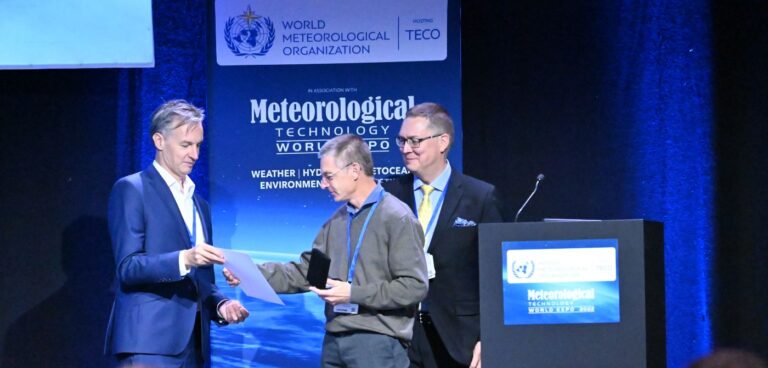The WMO Technical Conference on Meteorological and Environmental Instruments and Methods of Observation (TECO-2022) has presented the Professor Dr Vilho Vaisälà Awards at Meteorological Technology World Expo, in Paris, France, on October 12, awarding the winners of the prestigious 2020 and 2022 accolades.
The first to receive an award was Do Huy Duong, deputy director of the Center for Hydro-Meteorological Observation, Vietnam Meteorological and Hydrological Administration – on behalf of his co-authors Duong Van Khanh, Nguyen Xuan Tuan and Mai Hai Tung. The researchers won the 2020 Professor Dr Vilho Vaisälà Award for the Development and Implementation of Instruments and Methods of Observation in Developing Countries.
The award was created to encourage and stimulate capacity development in instruments and methods of observation for the WMO Integrated Global Observing System (WIGOS) in developing countries. The researchers won the award for their paper Automation solution to manage technical operations and transfer the real-time information from manual meteorological and hydrological stations in Viet Nam, which was published in Vietnam Journal of Hydro-Meteorology, No.691, 25 July 2018.
To achieve the award, the research had to be significant in its contribution to the long-term stability and reliability of meteorological and related environmental observations in developing countries. It also had to be relevant to the observing systems in developing countries. Finally, the research had to bring value through its results to WMO programs and key priority areas.
The 2020 Professor Dr Vilho Välsälä Award for an Outstanding Research Paper on Instruments and Methods of Observation was bestowed upon Julian Gröbner, senior scientist and co-head of the World Radiation Center, on behalf of his co-author Natalia Kouremeti, atmospheric physics researcher at Physikalisch-Meteorologisches Observatorium Davos. After receiving the award, Gröbner discussed the winning paper, named The Precision Solar Spectroradiometer (PS) for direct solar irradiance measurements, which was published in Solar Energy 185, p199-210. The instrument created in-house within this project was designed to create broad measurements and precise estimations of energy yields of photovoltaic devices. These measurements are expected to enable the determination of spectral mismatch factor and energy yield for the specific characteristics of the PV device. This award was created to recognize and encourage and stimulate interest in research in the field of instruments and methods of observation in support of WMO programs. The research was judged on: the significance of its topic; the novelty of its ideas and methods; and the value of its results to WMO programs.
The 2022 Professor Dr Vilho Väisälä Award for the Development and Implementation of Instruments and Methods of Observation in Developing Countries was awarded to the authors of the paper Unified AWS Data Collection, Integration and Processing Systems (UNI-AWS DCIPS). Published as a Project Report by Direction de la Météorologie, 2021, the research was conducted by: Chemseddine El Garrai, head of computer systems at the National Meteorological service of Morocco; Abdelazize Ait Hra, IT engineer in the National Forecasting Center of the National Meteorological Service of Morocco; Youssef Darrari, head of telecommunication and data processing at the Directorate General of Meteorology (DGM) of Morocco.
The 2022 Professor Dr Vilho Väisälä Award for an Outstanding Research Paper on Instruments and Methods of Observation was awarded to the authors of the Spectrum calibration of the first hyperspectral infrared measurements from a geostationary platform: Method and preliminary assessment. This paper was published in the Quarterly Journal of the Royal Meteorological Society, 2021. In the acceptance presentation, the researchers highlighted that the preliminary assessments from both international and domestic sources revealed that radiometric biases of GIIRS are less than 1K for warm window channels, and its spectral shifts of both LW and MW bands are less than 10ppm. Meanwhile, FY-4A/GIIRS L1 radiance are assimilated by some NWP users, and more applications are also undergoing extensively.
The researchers honored include: Qiang Guo, professor, chief scientist and engineer of ground segment for Chinese GEO microwave satellite (FY-4M), National Satellite Meteorological Center, China Meteorological Administration; Jun Yang, professor, chief scientist and engineer of Chinese meteorological satellite mission, National Satellite Meteorological Center, China Meteorological Administration; Caiying Wei, professor, chief commander of ground segment for Chinese Fengyun-4 satellites, National Satellite Meteorological Center, China Meteorological Administration; Boyang Chen, professor, National Satellite Meteorological Center, China Meteorological Administration; Xin Wang, professor and chief expert of meteorological application at China Meteorological Administration, National Satellite Meteorological Center, China Meteorological Administration; Changpei Han, professor, deputy principal in charge of GIIRS design and principal in charge of AGRI design, Shanghai Institute of Technical Physics, Chinese Academy of Science; Wen Hui, senior engineer at the National Satellite Meteorological Center, China Meteorological Administration; Weiwei Xu, senior engineer, National Satellite Meteorological Center, China Meteorological Administration; Rui Wen, assistant engineer, Sichuan Meteorological Observatory, China Meteorological Administration; and Yuning Liu, postgraduate, Chinese Academy of Meteorological Science, China Meteorological Administration.
For access to the live stream of the WMO TECO-2022 conference please register here.



